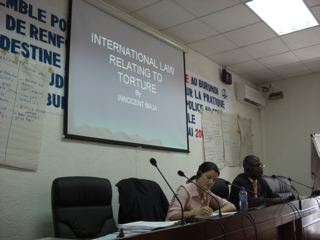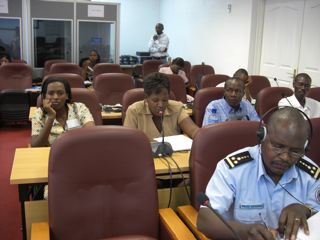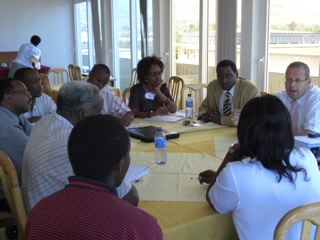
That night we met with our partner Pierre. He was nervous about the training. He had seen our training plan and didn’t think it would work. He told us that Burundians are shy, reserved people who would be uncomfortable sharing their values and participating in the other training exercises we had designed. I was also feeling nervous and Mehdi confided that he had felt like taking the next flight back to France.
We all woke up very early the next day, ready to begin. I was feeling like I always did on the morning of a trial: anxious, stressed and vaguely unwell. I wondered if people would show up. What kind of solutions could we offer people who have suffered the kind of social upheaval that Burundi experienced? Would the training address the major needs to overhaul a system in need of much attention and fixing?
 |
People were streaming into the state of the art conference center at the Hotel Amohoro by 8:30. “Amohoro” means peace in Kirundi. The hotel manager was very anxious to make a good impression since they had made a major investment in their conference room. It was state of the art – especially for a hotel in the developed world. A full sound system was available with individual microphones and head sets. This training would be the first major event to use his new facility. |
Outside the actual meeting area was a second room with a 360-degree view of the city. To the east you could see Lake Tanganyika. To the west were the hills from where the rebels had recently initiated their sniper fire. The view was lovely. In fact, Burundi is often referred to as the Switzerland of Africa. I saw why.Pierre Claver Mbonimpa opened the conference with welcoming remarks that outlined the desperate need to protect individuals from torture and mistreatment, followed by Karen’s opening message of hope and solidarity. The room contained 60 people – police in uniforms, judges, lawyers, prosecutors and civil activists. They listened attentively to the opening remarks.
We started the first exercise of the day. We displayed a series of questions on the wall designed to elicit the values that inspired the participants to enter their respective professions. Each person had a notebook to write their answers. Each professional group identified the values that were most important to them. The first group to report back was the police. I didn’t know what to expect. I have my own anti-police biases. What they valued most were respect, legality, impartiality, integrity, service and professionalism. The civil society spoke eloquently of equality and love of their country. The prosecutors spoke of integrity, impartiality, patience, legality, respect for human rights and professionalism. The defenders identified independence, defense of just cause, professionalism, loyalty, fraternity, dignity, humanity, honor and courage.
By the time we broke for lunch my anxiety had been transformed into a feeling of affinity with the group. Each group expressed what they were seeking in slightly different terms but the end result was the same -a quest for justice. The defenders heard the police speak the same words and share the same dreams that they did. The prosecutors were motivated by the same goals as the civil society.
That afternoon we showed six pictures and built a hypothetical case around the pictures. The first picture was designed to suggest some kind of a crime. It was a picture of a couple standing in front of a broken window. We had intentionally made the misdeed inconsequential to allow the group to fill in the facts so that it would be culturally relevant. That is exactly what happened.
| Each group of participants broke into their professional groups to answer the questions associated with each picture of the hypothetical. The questions were designed to be open-ended leaving room for cultural interpretation. What we thought we would see was a simple story of petty misconduct from the police and prosecutors. We assumed the defenders’ perspective would include police misconduct and two innocent people. |  |
Instead, each group looked at the pictures from the same cultural prism and came up with an almost the identical story. The story reflected the larger reality of years of victimization of ordinary citizens. The story they told was their story of random violence perpetrated on people just wanting to get on with their life.
Having not been to Bujumbura before, we hadn’t realized that the city is riddled with broken windows that never get fixed. The windows are not the work of kids throwing rocks or petty thieves reaching into store fronts to help themselves to someone else’s property. Windows are shot out by rebels who are engaged in an on-going ethnic civil war. Our attempt to show a picture that would not raise a red flag did just the opposite. For the participants, a picture of a broken window is a symbol of their broken country. And each and every one of them is victimized by the ramifications of this broken society. Innocent men and women get drawn into the fray just by walking down the street. No one is exempt from the residual detritus of a war-torn society. A broken window is synonymous with the war. Rebels had engaged in a shooting and windows were broken. Ordinary citizens called the police to report the shootings. The police arrived and found this innocent couple at the site and arrested them for further investigation.
We had a hypothetical case that spoke to the everyday problems of everyday people living in a conflict zone. This hypothetical would serve as a reference point for the group to articulate problems and potential solutions. By personalizing an archetypal story they had also begun a process through story-telling.
Day two started off by Karen reciting a poem and an invitation for volunteers to join in telling a story or reciting a poem. The first exercise of the day was to list weaknesses and strengths of the existing judicial system. After a half hour discussion, the different groups reported on what was and wasn’t working. A police officer noted the absence of defense lawyers during the arrest and interrogation phase. Magistrates and prosecutors articulated the need for more defenders to represent the victims of crime. Universal themes, everyone recognized, were jail overcrowding, pretrial delay, arbitrary arrests, unchecked violence to force confessions and an overall lack of respect for the laws.
The next lecture began to tackle these problems by focusing on solutions by enforcing existing provisions of the Burundi penal and procedure code. The Burundi code set limits on how long a suspect can remain in pretrial detention before appearing before the magistrates. This law is typically ignored because the system is over-taxed with prisoners held in local jails and prisons for months and even years without ever going to court. It is such a common problem that the practitioners have become desensitized to it. But everyone had just reaffirmed the will to respect the law. It wasn’t terribly difficult for the group to make the leap from the commonly voiced aspiration to respect the law – to the pragmatic translation of that aspiration into a practical application. Respect for the law necessitated enforcing the rules set for pretrial detention. Defenders needed to bring these cases to the court. Prosecutors needed to dismiss cases where the law was violated.
Magistrates needed to enforce the limitations and apply the law equally. Everybody was equally at fault and everybody had the potential to begin change immediately. To fail to do something would contradict their beliefs. The power to begin changing the system was palpable. The fact that detaining people beyond the proscribed times limits constituted mistreatment was identified. The participants debated their priorities, respect for the law, respect for the community, presumption of innocence and obligations and responsibilities of the judges to release. Ultimately the values that had been articulated on day one –respect for the dignity of the individual and presumption of innocence within a framework that prioritized the rule of law was the key that would unlock the jails and begin to solve the problem of pretrial delay.
The afternoon lecture further refined the issue of pretrial detention.
The rest of the day was spent in groups exploring the power of the law and strategies for protecting the very values they had agreed were worth protecting. Proposed legislative changes to the penal code were explained and debated. People agreed and disagreed with a healthy respect.
 |
On day three people shared their poems reflecting their dreams for the future of their country: ending torture and reinforcing justice, liberty and dignity. The defenders met for an in-depth strategy discussion about how to use the constitution and the rules of nullity and other legal protection to safeguard their clients. The civil society group began organizing a project they could undertake to advance the system. |
During the afternoon, roles were assigned to dramatize the original hypothetical story by imagining what would happen to these two individuals from the time of arrest until their appearance before the magistrates. A few new facts were introduced to create circumstantial evidence of guilt. The male suspect, now identified as Mr. King, had been associated with a rebel group several years before. After his arrest, his house was searched illegally and an inoperable Kalashnikov rifle was seized. Roles were assigned so that the participants could “get into the head” of their adversaries within the system.
Three defenders would perform the judges’ job. Two prosecutors stepped into the shoes of the accused. A police officer played the part of the defender. The defenders stepped into the judges’ role with zeal belittling Mr. King every time he tried to profess his innocence. They saw their role as extracting a confession. Everything short of a confession was a lie. He was insulted, marginalized and hectored. During this judicial interrogation he was ordered to kneel before the court. Is this a regular event in the criminal courts? Were the defenders overly emboldened by their new-found power? How must it have felt for the actual prosecutor, now in his role as the accused, to be humiliated and forced to his knees by the very court he usually works with. When the police officer appeared, as the defender, to assist his client, he was ordered from the court room. His services would only interfere with the fact finding mission of gaining a confession regardless of the truth. When the accused still did not admit complicity in a crime, he was removed from the court room and beaten by his jailors.
The next morning three men stood to begin the day’s activities. They had obviously planned something because they had printed pieces of paper in their hands. Referring to their script they began to sing a cappella “John Browns Body Lies a Moldering in the Grave” to the tune of “The Battle Hymn of the Republic.” In Bujumbura, a prosecutor, judge, and civil activist were singing about the American abolitionist who tried to free the slaves. John Brown’s planned uprising at Harper’s Ferry failed in the short run, but was a catalyst for other abolitionists and a precursor to the emancipation of the slaves. I stood to join with the others in the singing.
The final planned activity of the training was the presentation of the trial of Mr. King and his friend for aiding rebels in disturbing the peace. Today the performers would reenact the trial from the perspective of their daily work in the system. Judges would judge, defenders would defend, prosecutors would prosecute and police would testify. Everybody got to work to prepare for the trial. During the four days leading up to this moment people had worked hard at the exercises. Now it was more real. That sense of importance pervaded the room. The participants had brought their robes. The defenders and prosecutors wore their black with white ermine collared robes. The magistrates put on their robes. The accused were ushered into the court room. The audience was silent. Two years of detention had passed since the time Mr. King had been bullied out of the court room. Now he and the co-defendant had two competent attorneys at their side. They had prepared motions that raised every claim and every misdeed that the system had perpetrated on their clients. They made motions to nullify the proceedings and release their clients for violating the pretrial detention rules. They prepared a motion for release based on the torture of Mr. King. They claimed a violation of his right to representation when the court had rejected his request for legal representation at the initial proceeding. The court took the motions under consideration requesting that the trial proceed on the merits. At this point both accused had the opportunity to make their case in eloquent proclamations of their innocence. Their lawyers presented the facts buttressing their claims of innocence. And the prosecutors attempted to demonstrate all the facts which could be interpreted as evidence of guilt. Witnesses were called to support the defendants. The police were called to testify. Finally the judges ruled. They had prepared written findings. They rose to their feet to underscore the importance of their role. And they ruled. No longer would torture be tolerated. No longer would clients languish in jail for years before a hearing. Justice could not be held back any longer. John Brown might lie a moldering in the grave but his message – to stand up and fight for what you believe in – was resonating through that room.
In my career as a public defender, I can claim to have set a few peoples’ lives straight. But I never thought I would have the chance to play a part in the transformation of a justice system. I think it actually happened.
The training was over. Four days ago we were strangers. Now we were partners in the same endeavor. It was time to celebrate our new relationships, new fervor, new skills and new resolve. The chairs and tables were removed. Music was piped in and we all started to dance together.